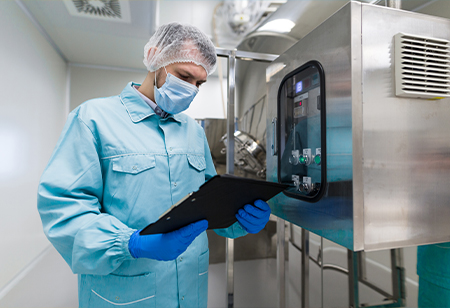Hridkamal Roy, Assistant Editor, India Pharma Outlook

The cleanroom technology market is estimated to reach a net value of 10.3 Bn USD by 2032 according to a report published by Global Market Insights. A substantial amount of this growth has been observed in the pharmaceutical industry globally. The Big Pharma sector has immensely benefitted from the latest cleanroom technology innovations and is taking definitive steps for integrating it completely into pharmaceutical manufacturing setups. The cleanroom technology has greatly evolved since its invention in 1962. As of now, with the integration of RPA (Robotic Process Automation), cleanrooms in pharmaceuticals can operate with very less or no human intervention thus reducing the risk of any contamination. The usages of robotics and automation in cleanrooms have also led to increased efficiency and productivity for the pharmaceutical industry and have resulted in providing higher-quality products. Furthermore, the integration of artificial intelligence (AI) and machine learning (ML) in the cleanroom sector is constantly gaining momentum. AI and ML are enabling real-time monitoring and control of the cleanroom environment and elevating the pharmaceutical cleanroom standards for the world.
The COVID-19 pandemic has made a considerable impact on the cleanroom market. It has shed light on the very importance of maintaining a sterile environment in the pharmaceuticals, biotechnology, and medical devices industries. It’s because in these industries contamination is a major cause for concern. The demand for cleanroom technologies has also increased because of the pandemic outbreak and are being widely used in the manufacturing of medical equipment like ventilators, masks and personal protective equipment (PPE) and other pharmaceutical cleanroom products and can be stated as the various factors as to why cleanroom technologies are on the rise with respect to the pharmaceutical industry globally.
“Cleanrooms are the foundation of preparing medicines in pharmaceuticals and broader life sciences. It’s important that the air going into the room is filtered and passes through a filter of appropriate article retention capacity. These are high-efficiency particulate air (HEPA) filters. Within pharmaceuticals and areas where sterile medicines are being produced, these HEPA filters need to be of a high retention capacity. Normally they're 99.97% efficient”, mentioned Dr. Tim Sandle, Microbiologist, Bio Products Laboratory.
In order understand how cleanroom market is expanding reaches in the pharmaceutical industry, one will need to delve deeper into the various factors that are influencing this growth.
New cleanroom infrastructures have been recently invented that are specifically dedicated to the cell and gene therapy sector and is currently growing at a very rapid pace.The pharmaceutical industry accounts close to 40 percent of the total market for cleanrooms and is currently incurring revenue of about $5 billion/year. Even though the adoption rate is growing slowly, the cleanroom market is growing at a steady CAGR of 8-10 percent annually. The growth rate has been comparatively lower because there has been lack of focus on the fact that even small cleanrooms can be able to maximize productivity and be impactful in larger spaces.
The gross count of all installed/in-use bio/pharmaceutical cleanrooms that abide by all required ISO certifications is slightly more than 8,000 globally. Market research predicts that there will be close to 11,000 pharmaceutical cleanrooms by the end of 2025 and 15,000 by 2030. Large numbers of cleanrooms will be addedto setups that are equipped for manufacturing cellular and viral vector gene therapies.
“BioPlan’s Top 1000 Biopharmaceutical Manufacturing Facilities Index includes approximately 1,050 bio processing and R&D facilities with ≥500 L total capacity (total onsite bioreactor volume), with each of these estimated to have on average just over three standard cleanrooms (a total of around 3,400 cleanrooms). In addition, another ~500 smaller bio processing facilities increase the total bio/pharma cleanrooms to around 4,500”, Ronald A Rader, Senior Director, Technical Research, BioPlan Associates.
Latest innovations of highly specialized surface coatings have immensely facilitated sanitation during the course of manufacturing. It is a known fact that in order to prevent contamination, most of the manufacturing units abide by goods manufacturing practices (GMP) standards so as to prevent contamination in the controlled clenroom environments. It is only by following standard GMP cleaning and sanitation guidelines, cleanroom employees are being successful in providing cleanroom operations consistently to develop Active Pharmaceutical Ingredients (APIs). API manufacturers are currently utilizing cleanrooms to ensure safely in the development of effective medicines that are mostly sensitive to microbes or SPM.
To give an example, for API pharmaceutical manufacturing, Moravek is a highly experienced and trusted manufacturing organization that offers contract services for custom GMP API pharmaceutical manufacturing with appropriate cleanroom facilities. Pairing alongside the organization’s expertise, it works to support businesses in clinical research and trials. The laboratory settings are equipped with cleanrooms to utilize all the benefits these controllable tools offer for manufacturing needs.
In the last decade, many technology integrations have been successful in the pharmaceutical cleanroom market and we have seen many renowned Big Pharma companies promoting this technology in their manufacturing setups. Many such technologies related to cleanrooms are under trial and will be present in the market in a few years.